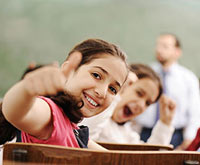If you have a child with ADHD you have to let them squirm if you want them to learn.
That’s right, the prevailing wisdom, of trying to keep them still to stay focused, has been turned on its head. New research indicates, that the movements that children with ADHD exhibit, are vital to how they remember information and work out complex cognitive tasks. Mark Rapport, one of the research study’s authors and head of the Children’s Learning Clinic at the University of Central Florida, said in a statement “The message isn’t ‘Let them run around the room,’ but you need to be able to facilitate their movement so they can maintain the level of alertness necessary for cognitive activities.”
In fact, Mark Rapport’s previous research had already demonstrated that the excessive movements, which are hallmarks of ADHD and appeared ever-present, were actually present when children with ADHD needed to use their executive brain functions, particularly their working memory.
By contrast, children in the study that did not have ADHD but moved more during the research study, performed worse.
If your child has ADHD it could be worthwhile to talk with your school about using techniques and devices that could provide the movement your child needs with minimal disruption to other students. Devices that have been used are activity balls, wobble cushions, bouncy bands for chairs and more.
More about ADHD:
– ADHD affects 5-10% of school age children.
– ADHD is characterized by three groups of symptoms, inattention, hyperactivity, and impulsivity.
– Children with ADHD can have trouble controlling their behavior and emotions, which can lead to lower social skills, isolation, dependence on others, and poor school performance.
– There is a strong relationship between ADHD and sleep problems, but it is not known if sleep problems cause ADHD or vice versa. (Sleep problems include trouble falling asleep, staying asleep, restless sleep, snoring or gasping during sleep.)
– What is know is that children with ADHD have higher rates of daytime drowsiness, sleep apnea (a pattern of interrupted breathing during sleep), restless leg syndrome and periodic leg movement syndrome, all of which affect the quality and duration of sleep.
– Children who are tired behave differently than adults who are tired. Adults become sluggish, whereas children speed up, become inattentive, hyperactive, impulsive and oppositional, all characteristics of ADHD.
– Sleepiness may explain why stimulant medications used to treat ADHD are effective in 80% of children diagnosed with ADHD. Just like adults who need coffee to counteract sleepiness, children who are tired may need stimulants to improve focus and attention.
– Many with ADHD are able to harness its positive aspects and use them to their advantage. These qualities can include creativity, intuition, imagination, know-how, industriousness, the ability to multi-task, the ability to hyper focus, the ability to tolerate and take risks and the ability to be clear and level headed during chaotic and unpredictable situations.
– According to Psychology Today “people with ADHD are 300% more likely to start their own business”.

